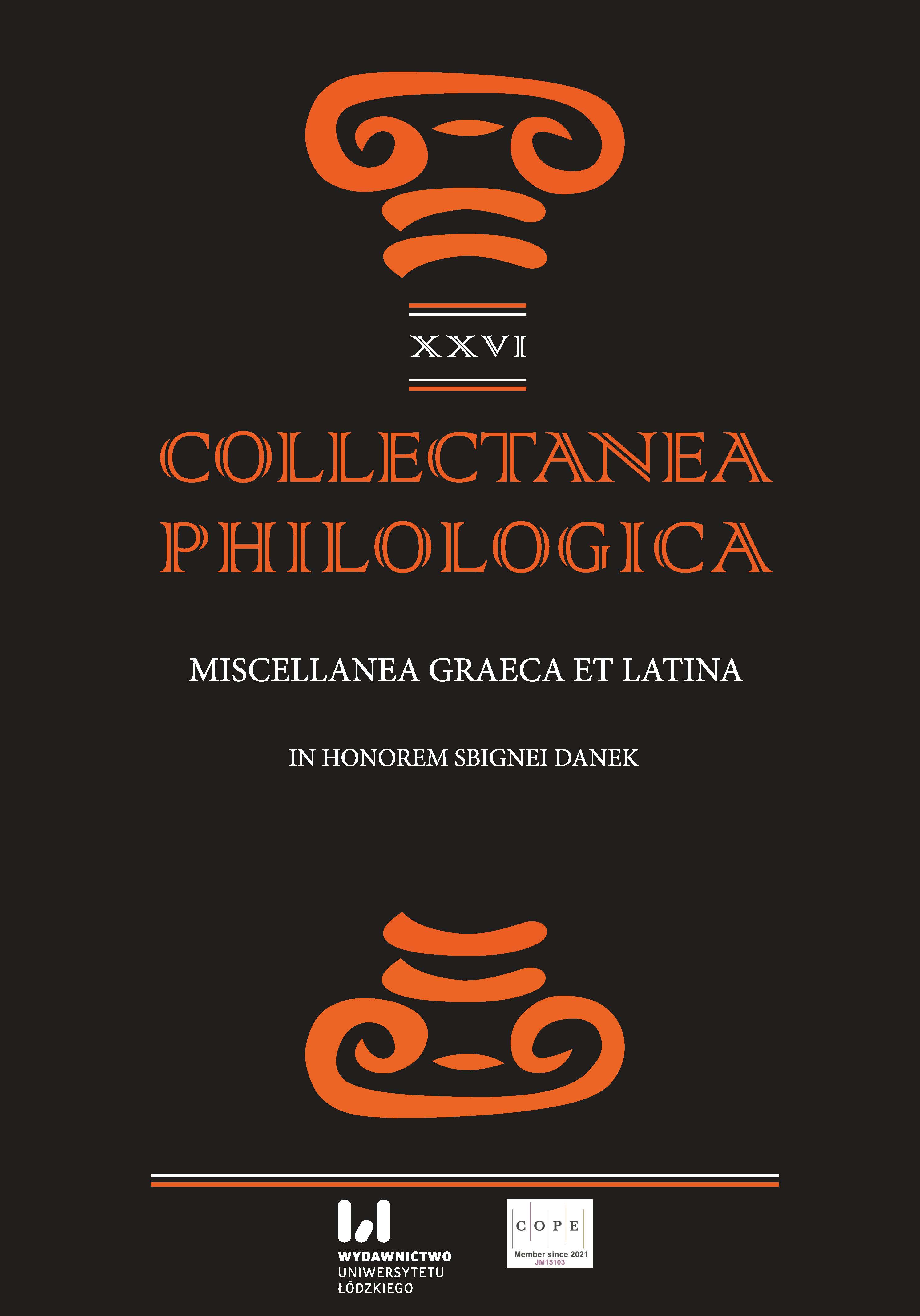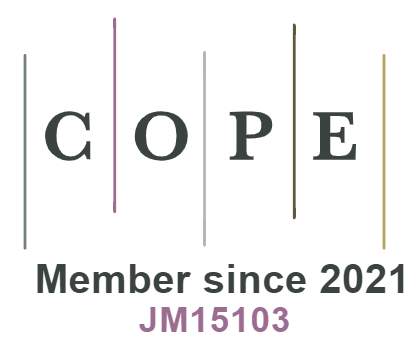Sic undique fulgor percussit. Ekfraza w VII eklodze Kalpurniusza Sykulusa
DOI:
https://doi.org/10.18778/1733-0319.26.12Słowa kluczowe:
Kalpurniusz Sykulus, poezja pasterska, ekfraza, rzymski amfiteatrAbstrakt
The aim of the article is to propose a new Polish translation of the ekphrastic passage of the VII Eclogue (vv. 23-72) by Calpurnius Siculus. It will be preceded by a short commentary, in which special emphasis will be placed on the means of artistic expression used by the poet. The 50-line ekphrastic passage is a story told by Corydon, who recalls his visit to Rome. It is the longest description of this type preserved in pastoral poetry. A shepherd, who wants to leave the countryside and go to the city to start a real literary career there, describes with delight the breathtaking amphitheatre. He is impressed by the splendour, rich ornamentation, as well as the animals exhibited in the arena. In addition to hares, horned boars, elk and bulls, Corydon could also admire sea monsters. All of them fit in with the tradition of locus horridus, which is in opposition to the topos of loci amoeni, i.e. an idyllic, safe place away from the hustle and bustle of the city (topos, which is well known from bucolic poetry).
Bibliografia
Calpurnius Siculus. (1982). Eclogue VII. In: J. Wight Duff, A.M. Duff (eds.). Minor Latin Poets. London: Harvard University Press. 280–285.
Google Scholar
Ovidius Naso P. (1998). Metamorphoses. W.S. Anderson (ed.). Stuttgart.
Google Scholar
DOI: https://doi.org/10.1515/9783110948547
Plutarchus. (1960–1968). Vitae parallelae. Vol. 1–2. Cl. Lindskog, K. Ziegler (eds.). Lipsiae: B.G. Teubneri.
Google Scholar
Varro M. Terentius. (1938). On the Latin Language. R.G. Kent (ed.). London: Harvard University Press.
Google Scholar
DOI: https://doi.org/10.4159/DLCL.varro-latin_language.1938
Baldwin, B. (1995). „Better Late than Early: Reflections on the Date of Calpurnius Siculus”. Illinois Classical Studies 20. 157–167.
Google Scholar
Champlin, E. (1978). „The Life and Times of Calpurnius Siculus”. JRS 68. 95–110.
Google Scholar
DOI: https://doi.org/10.2307/299629
Curtius, M. (2005). Literatura europejska i łacińskie średniowiecze. Przeł. A. Bobrowski. Kraków: Universitas.
Google Scholar
Cytowska, M., Szelest, H. (1992). Literatura rzymska. Okres cesarstwa. Warszawa: PWN.
Google Scholar
Dziadek, A. (2004). Obrazy i wiersze: z zagadnień interferencji sztuk w polskiej poezji współczesnej. Katowice: Wydawnictwo Uniwersytetu Śląskiego.
Google Scholar
Dziadek, A. (2018). Ilustrowany słownik terminów literackich. Z. Kadłubek, B. Mytych-Forajter, A. Nawarecki (red.). Gdańsk: Wydawnictwo słowo/obraz terytoria.
Google Scholar
Eisner, J. (2002). „The Genres of Ekphrasis”. Ramus 31. 1–18.
Google Scholar
DOI: https://doi.org/10.1017/S0048671X00001338
Epplett, Ch. (2019). Gladiatorzy i walki z dzikimi zwierzętami na arenach. Przeł. I. Michałowska-Gabrych. Kraków: Wydawnictwo Astra.
Google Scholar
Głowiński, M. (2008). Słownik terminów literackich. Wrocław: Zakład Narodowy im. Ossolińskich.
Google Scholar
Green, S.J. (2009). „The Horse and the Serpent: A Vergilian Perspective on the Final Eclogue of Calpurnius Siculus”. Vergilius 55. 55–67.
Google Scholar
Gryksa, E. (2020). Walory estetyczne Eklogi VI Kalpurniusza Sykulusa. W: E. Gryksa (red.). Szkice o antyku. T. VI: Człowiek w relacji z naturą. Katowice: Uniwersytet Śląski. 51–68.
Google Scholar
Hubbard, T.K. (1996). „Calpurnius Siculus and the Unbearable Weight of Tradition”. Helios 23. 67–89.
Google Scholar
Hulsenboom, P. (2013). “Now I have forgotten all my verses”: Social Memory in the Eclogues of Virgil and Calpurnius Siculus. In: K. Fordoński, P. Wojtas (eds.). Language and Literary Studies of Warsaw. Warszawa: Lingwistyczna Szkoła Wyższa. 13–28.
Google Scholar
Jennison, G. (1922). „Polar Bears at Rome. Calpurnius Siculus, Ecl. VII. 65-6”. The Classical Review 36 (3/4 May Jun.). 73.
Google Scholar
DOI: https://doi.org/10.1017/S0009840X00016231
Karakasis, E. (2018). T. Calpurnius Siculus. A Pastoral Poet in Neronian Rome. Berlin: De Gruyter.
Google Scholar
Kocur, M. (2005). We władzy teatru. Aktorzy i widzowie w antycznym Rzymie. Wrocław: Wydawnictwo Uniwersytetu Wrocławskiego.
Google Scholar
Magnelli, E. (2006). Bucolic Tradition and Poetic Programme in Calpurnius Siculus. In: M. Fantuzzi, T. Papanghelis (eds.). Brill’s Companion to Greek and Latin Pastoral. Boston: Brill. 467–477.
Google Scholar
DOI: https://doi.org/10.1163/9789047408536_020
Martin, B. (2003). Calpurnius Siculus: The Ultimate Imperial ‘Toady’? In: A.F. Basson, W.J. Dominik (eds.). Literature, Art, History: Studies on Classical Antiquity and Tradition in Honour of W.J. Henderson. Frankfurt. 73–90.
Google Scholar
Meyer, R. (1980). „Calpurnius Siculus: Technique and Date”. JRS 70. 175–176.
Google Scholar
DOI: https://doi.org/10.2307/299562
Newlands, C. (1987). „Urban Pastoral: The Seventh «Eclogue» of Calpurnius Siculus”. Classical Antiquity 6 (2 Oct.). 218–231.
Google Scholar
DOI: https://doi.org/10.2307/25010869
Radziewicz, T. (2017). Od ekfrazy do infrazy. W: K. Andruczyk, E. Gorlewska, K. Korotkich (red.). Logos – filozofia słowa. Szkice o pograniczach języka, filozofii i literatury. Białystok: Uniwersytet w Białymstoku. 167–181.
Google Scholar
Salvo, L di. (1990). T. Calpurnio Siculo. Ecloga VII. Bologna: Patron Editore.
Google Scholar
Słapek, D. (2010). Sport i widowiska w świecie antycznym. Kraków: Homini.
Google Scholar
Townend, G.B. (1980). „Calpurnius Siculus and the munus Neronis”. JRS 70. 166–174.
Google Scholar
DOI: https://doi.org/10.2307/299561
Witosz, E. (2009). „Ekfraza w tekście użytkowym w perspektywie genologicznej i dyskursywnej”. Teksty drugie 1–2. 105–125.
Google Scholar
Zeitlin, F. (2013). „Figure: Ekphrasis”. Greece and Rome 60 (1). 17–31. https://doi.org/10.1017/S0017383512000241
Google Scholar
DOI: https://doi.org/10.1017/S0017383512000241
Opublikowane
Jak cytować
Numer
Dział
Licencja

Utwór dostępny jest na licencji Creative Commons Uznanie autorstwa – Użycie niekomercyjne – Bez utworów zależnych 4.0 Międzynarodowe.












